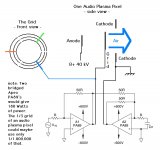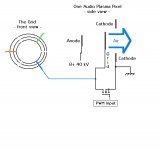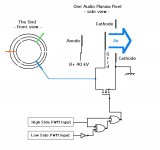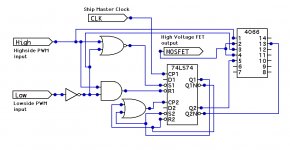42bit 96kfps Holo-Sound, WYSIWYG
Thanks for all this
That's just what happens when one is almost starved to death on sound.
I believe this is a logical progression, that 'Holo-Sound' will soon be as common as a veggie hamburger. Affordable also.
All the various audio scaling and modeling could require some really dense processing though....
To have true WYSIWYG a 17 bit pixel depth, a (17 bit height and 18 bit width) x 3 would be needed = 56bit 96kfps
Nixie said:Do I smell a business opportunity here?
I'll be your North American representative. $-)
dnsey said:Your 'trasducer grid' is a brilliant idea - and a great bit of lateral thinking!
Thanks for all this
That's just what happens when one is almost starved to death on sound.
I believe this is a logical progression, that 'Holo-Sound' will soon be as common as a veggie hamburger. Affordable also.
All the various audio scaling and modeling could require some really dense processing though....
To have true WYSIWYG a 17 bit pixel depth, a (17 bit height and 18 bit width) x 3 would be needed = 56bit 96kfps
Re: 42bit 96kfps Holo-Sound, WYSIWYG
Actually, I was half-serious in my comment.Indalhc said:Thanks for all this
I'm not sure if this is the most logical direction, though. It's more ecomonic to feed directly to the ear. My view of the future is that everyone has their individual HRTF measured, so that then just two transducers in the ear are sufficient to create any possible soundscape. Now we have canal phones, eventually we may have direct-neural connections for everyone. But the individual's HRTF is the critical thing.I believe this is a logical progression, that 'Holo-Sound' will soon be as common as a veggie hamburger.
42bit 96kfps Holo-Sound, This could be even better than the real thing
You have a point there (although I'm not on-the-spot familiar with the abbreviation).
About cost, nanotech will make everything more inexpensive. I think we can have a little of both actually. The audio plasma wall would be more of a physical experience. It could possibly also be classified as a more or less regulated drug. As in 'instant synaesthesia' induction.... many area's yet unexplored
Nixie said:
Actually, I was half-serious in my comment.
I'm not sure if this is the most logical direction, though. It's more ecomonic to feed directly to the ear. My view of the future is that everyone has their individual HRTF measured, so that then just two transducers in the ear are sufficient to create any possible soundscape. Now we have canal phones, eventually we may have direct-neural connections for everyone. But the individual's HRTF is the critical thing.
You have a point there (although I'm not on-the-spot familiar with the abbreviation).
About cost, nanotech will make everything more inexpensive. I think we can have a little of both actually. The audio plasma wall would be more of a physical experience. It could possibly also be classified as a more or less regulated drug. As in 'instant synaesthesia' induction.... many area's yet unexplored
42bit 96kfps Holographic Sound Project
Back a little to business here.
It should be possible to hold a electrodynamic Biefeld-Brown
field at 2kV, however its bass frequency response would be
lacking.
The frequency response from a pixellated audio plasma wall could/should
be good/linear all the way from DC.
Nixie said:About 2 kV across the discharge. Much less across the MHCD itself.
Back a little to business here.
It should be possible to hold a electrodynamic Biefeld-Brown
field at 2kV, however its bass frequency response would be
lacking.
The frequency response from a pixellated audio plasma wall could/should
be good/linear all the way from DC.
42bit 96kfps Holographic Sound Project
This could rather be, 'If anyone over at places like Skywalker Sound
is listening, you apparently have many willing workers'
Nixie said:
Actually, I was half-serious in my comment.
This could rather be, 'If anyone over at places like Skywalker Sound
is listening, you apparently have many willing workers'
42bit 96kfps Holographic Sound Project, 'The Works'
.... many, at large d:
Here is a suggested design for the grid coupling/audio
modulation of one audio plasma pixel module, using
two bridge coupled Apex PA89 high voltage op-amps.
They give 180 W, so more than enough power for the
prototype
The lower part of this schematic is from the PA89 data sheet.
Further comments and suggestions are welcome.
.... many, at large d:
Here is a suggested design for the grid coupling/audio
modulation of one audio plasma pixel module, using
two bridge coupled Apex PA89 high voltage op-amps.
They give 180 W, so more than enough power for the
prototype
The lower part of this schematic is from the PA89 data sheet.
Further comments and suggestions are welcome.
Attachments
42bit 96kfps Holographic Sound Project
Here is a PWM input-ready version of the audio plasma
pixel unit.
Its cathode is again more ´safe to the touch´.
(The previous version would seem to require an amplitude
inverter module added to the input - I hope none here got
travel sick d:
Here is a PWM input-ready version of the audio plasma
pixel unit.
Its cathode is again more ´safe to the touch´.
(The previous version would seem to require an amplitude
inverter module added to the input - I hope none here got
travel sick d:
Attachments
Differential to Single Ended PWM Converter
I couldn't find a PWM amplifier/driver with a single ended output so
I made this converter below instead. It has/gives some glitches in
the zero crossing area, however it should still be OK for these early
tests on the prototype.
Now I have to find a high voltage capable Field Effect Transistor.
I couldn't find a PWM amplifier/driver with a single ended output so
I made this converter below instead. It has/gives some glitches in
the zero crossing area, however it should still be OK for these early
tests on the prototype.
Now I have to find a high voltage capable Field Effect Transistor.
Attachments
I wonder if you could modify this: http://www.ramseyelectronics.com/cgi-bin/commerce.exe?preadd=action&key=IG7
by adding a grid to make a tweeter? How cool would that be? 
42bit 96kfps Holographic Sound Project
Sorry about that earlier mess!
And maybe also the following new attempt on making
a differential to single ended PWM signal converter
- digital logic isn't really my field...
I am certain there are better ways doing this - it can
be a little tricky to get everything right around the zero
crossing area, to avoid losing parts of the wave.
Sorry about that earlier mess!
And maybe also the following new attempt on making
a differential to single ended PWM signal converter
- digital logic isn't really my field...
I am certain there are better ways doing this - it can
be a little tricky to get everything right around the zero
crossing area, to avoid losing parts of the wave.
Attachments
42bit 96kfps Holographic Sound Project
From the webpage <<This nifty kit includes a pre-made high voltage ion generator potted for your protection, and probably the best one available for the price. It also includes a neat experiment called an "ion wind generator". >>
Yes, that ion generator could possibly be good for experiments in this field d: but the Biefeld-Brown field is certainly a bit higher. Maybe it could be interesting to even go past 100 kV
With a high bias maybe it would be sufficient with a fairly low grid control voltage, say <500 Volts.
bigwill said:I wonder if you could modify this: http://www.ramseyelectronics.com/cgi-bin/commerce.exe?preadd=action&key=IG7 by adding a grid to make a tweeter? How cool would that be?
From the webpage <<This nifty kit includes a pre-made high voltage ion generator potted for your protection, and probably the best one available for the price. It also includes a neat experiment called an "ion wind generator". >>
Yes, that ion generator could possibly be good for experiments in this field d: but the Biefeld-Brown field is certainly a bit higher. Maybe it could be interesting to even go past 100 kV
With a high bias maybe it would be sufficient with a fairly low grid control voltage, say <500 Volts.
The Audion celebrates a hundred years this year!
The analogy with the thermionic valves is basically the use of a control grid, everything else
is reversed here (it seems)
el`Ol said:The SE valve amps I know work with positive voltage. You could ask in the tubes forum whether there is one with negative voltage.
The analogy with the thermionic valves is basically the use of a control grid, everything else
is reversed here (it seems)
The Field
Thinking a little deeper. I believe that to make use of the grid and the
Field it is necessary to operate at >20 kV.
More about the PWM modulation, I think I'll rather try to do this
from scratch, it seems to be equally simple and the result compared
to building a 'rough' converter would most probably sound much better.
Audio to PWM as follows. Run audio in parallel with a 40 kHz triangle-wave
through a comparator and voila, we now have a useful PWM output
to feed the plasma grid FET.
bigwill said:I wonder if you could modify this: http://www.ramseyelectronics.com/cgi-bin/commerce.exe?preadd=action&key=IG7 by adding a grid to make a tweeter? How cool would that be?
Thinking a little deeper. I believe that to make use of the grid and the
Field it is necessary to operate at >20 kV.
More about the PWM modulation, I think I'll rather try to do this
from scratch, it seems to be equally simple and the result compared
to building a 'rough' converter would most probably sound much better.
Audio to PWM as follows. Run audio in parallel with a 40 kHz triangle-wave
through a comparator and voila, we now have a useful PWM output
to feed the plasma grid FET.
Just came across this thread- Could you make a prototype out of an Ionic Breeze?
http://www.sharperimage.com/us/en/catalog/productdetails/sku__SI857GRY/catid__101/pcatid__1
That way you already have an ionic wind generater (which also already uses catalists to stop ozone). Then you just need to figure out what needs to be done to make it make sound and what improvements need to be made for audio purposes...
http://www.sharperimage.com/us/en/catalog/productdetails/sku__SI857GRY/catid__101/pcatid__1
That way you already have an ionic wind generater (which also already uses catalists to stop ozone). Then you just need to figure out what needs to be done to make it make sound and what improvements need to be made for audio purposes...
- Status
- This old topic is closed. If you want to reopen this topic, contact a moderator using the "Report Post" button.
- Home
- Loudspeakers
- Planars & Exotics
- 'Biefeld-Brown effect' based full range drivers




